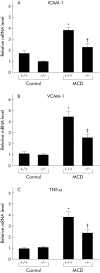Tumour necrosis factor alpha signalling through activation of Kupffer cells plays an essential role in liver fibrosis of non-alcoholic steatohepatitis in mice
- PMID: 16174657
- PMCID: PMC1856073
- DOI: 10.1136/gut.2005.071118
Tumour necrosis factor alpha signalling through activation of Kupffer cells plays an essential role in liver fibrosis of non-alcoholic steatohepatitis in mice
Abstract
Background: While tumour necrosis factor alpha (TNF-alpha) appears to be associated with the development of non-alcoholic steatohepatitis (NASH), its precise role in the pathogenesis of NASH is not well understood.
Methods: Male mice deficient in both TNF receptors 1 (TNFR1) and 2 (TNFR2) (TNFRDKO mice) and wild-type mice were fed a methionine and choline deficient (MCD) diet or a control diet for eight weeks, maintaining isoenergetic intake.
Results: MCD dietary feeding of TNFRDKO mice for eight weeks resulted in attenuated liver steatosis and fibrosis compared with control wild-type mice. In the liver, the number of activated hepatic Kupffer cells recruited was significantly decreased in TNFRDKO mice after MCD dietary feeding. In addition, hepatic induction of TNF-alpha, vascular cell adhesion molecule 1, and intracellular adhesion molecule 1 was significantly suppressed in TNFRDKO mice. While in control animals MCD dietary feeding dramatically increased mRNA expression of tissue inhibitor of metalloproteinase 1 (TIMP-1) in both whole liver and hepatic stellate cells, concomitant with enhanced activation of hepatic stellate cells, both factors were significantly lower in TNFRDKO mice. In primary cultures, TNF-alpha administration enhanced TIMP-1 mRNA expression in activated hepatic stellate cells and suppressed apoptotic induction in activated hepatic stellate cells. Inhibition of TNF induced TIMP-1 upregulation by TIMP-1 specific siRNA reversed the apoptotic suppression seen in hepatic stellate cells.
Conclusions: Enhancement of the TNF-alpha/TNFR mediated signalling pathway via activation of Kupffer cells in an autocrine or paracrine manner may be critically involved in the pathogenesis of liver fibrosis in this NASH animal model.
Conflict of interest statement
Conflict of interest: None declared.
References
MeSH terms
Substances
LinkOut - more resources
Full Text Sources
Other Literature Sources
Molecular Biology Databases
Research Materials
Miscellaneous











